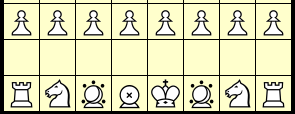Turnover
Turnover
- Chess Fusion oriented.
- Based on Othello’s (Reversi) turning pieces ability.
- Moves based on Chess moves.
- Uses flat pieces like pieces from Checkers to improve semiotic performance when players visualise and recognize pieces and possible moves.
- With only three different pieces, an external and internal ring and a main button, the arrangement turns it simple and complex at same time.
- Turnover has Beauty of Go, Grace of Checkers, Power of Reversi, Wisdom of Chess.
- Best chess variant of all time.
- Designed by brazilian designer Lúcio José Patrocínio Filho.
Pieces


Rules
Turnover Chess Variant
Languages available: ESPAÑOL | PORTUGUÊS
- It is a game about take and turnover pieces between 2 players.
- First player to perform checkmate at all enemy Castles wins the match.
- In other words, first player who take all opponent Castles, wins the match.
- First player to perform checkmate at all enemy Castles wins the match.
Pieces
- Each player has 24 pieces, initially arranged in 8 groups of three concentric pieces in the first row of each player.
- There are three kinds of pieces, two of them like rings, concentric with a mid button.
- Pieces setup on each square determines outer piece move.
- Only one piece can be moved per turn and the piece to be moved is the outermost on square.
- When position changes, new combinations determine new kinds of movements.
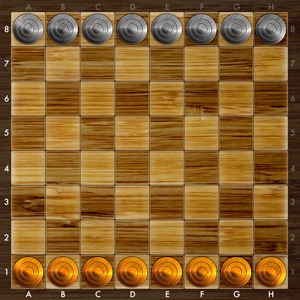
Turnover
- Pieces are double-sided in white and black.
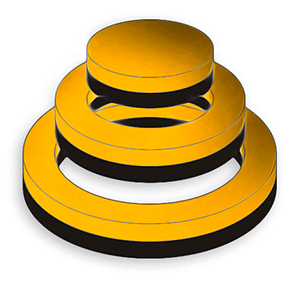
- When player overlaps a piece that fits each other, it is not removed from the board; in other words, it is not a take, but rather, a turnover. In this case, pieces must be flipped to match color.

Pawn (external ring alone)
- Moves just one square per turn.
- Turnovers enemy or friendly pieces ahead and diagonally forward.
- Turnovers a friendly or enemy Bishop to turns it in a friendly Knight.
- Turnovers a friendly or enemy Queen to turns it in a friendly Castle.
- Remembering: Pawn cannot take pieces ahead.
- One square diagonally forward.
- Takes Castles, Pawns, Rooks and Knights.
- Turnover Queens and Bishops.
- Pawn does not fit with Rook and vice-versa.
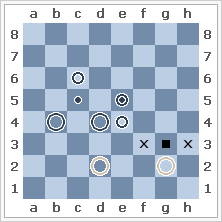
Pawn, Knight and Castle's Promotion
- When Pawn reaches board’s last row (row 8 for white or 1 for black) and there is no turnover, in other words, only Pawn remains in square, it is promoted to Queen.
- When Pawn reaches board’s last row (row 8 for white or 1 for black) in turnover with Queen, in other words, Pawn turnover in Castle on last row, so this Castle is promoted to Queen.
- When Rook turnovers in Castle on last row (row 8 for white or 1 for black) in turnover with Knight, so this Castle is promoted to Queen.
- When Knight moves to board’s last row (row 8 for white or 1 for black) and there is no turnover, in other words, only Pawn from Knight remains in square, it is promoted to Queen.
- When Knight moves to board’s last row (row 8 for white or 1 for black) and turnover with Bishop, in other words, Pawn from Knight turnovers with Bishop, it is not promoted, instead it is a Knight.
- Gold rule for promotions: Only Pawns and Castles can be promoted to Queen.
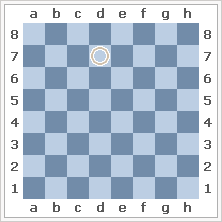
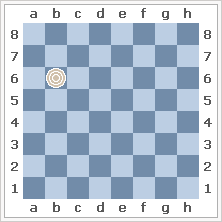
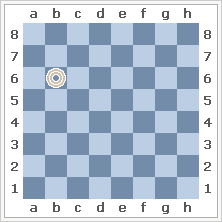
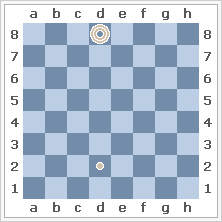
Bishop (internal ring alone)
- Moves any number of vacant squares in any diagonal direction.
- Can be combined with a friendly or enemy Pawn to turns it in a friendly Knight.
- Can be combined with a friendly or enemy Rook to turns it in a friendly Queen.
- Takes: Castles, Bishops, Knights and enemy Queens.
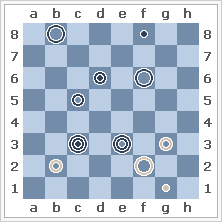
Rook (central button alone)
- Moves any number of vacant squares in orthogonal (in a horizontal or vertical direction).
- Can be combined with a friendly or enemy Bishop to turns it in a friendly Queen.
- Can be combined with a friendly or enemy Knight to turns it in a friendly Castle.
- Takes: Castles, Rooks, Pawns and enemy Queens.
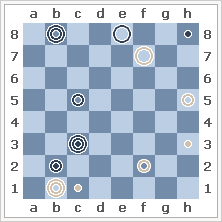
Combined Pieces
- Pieces can be combined each other since it matches.
- Just Rook and Pawn do not match each other.
- This combination determines the kind of movement to be performed by outermost piece of set.
- When turnovering, opponent pieces need to be flipped to fit same color.
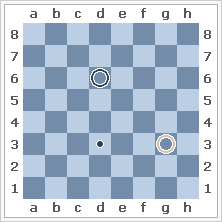
Queen (central button + internal ring)
- Moves her Bishop piece in orthogonal or diagonal direction, as many vacant squares as possible in one direction.
- Combines her Bishop's piece with a friendly or enemy Pawn to turns it in a friendly Knight.
- Combines her Bishop's piece with a friendly or enemy Rook to turns it in a friendly Queen.
- Takes with her Bishop's piece: Queens, Knights, Bishops and enemy Castles.
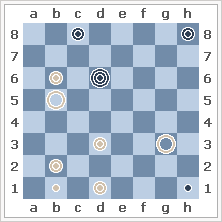
Castle (central button + external ring + internal ring)
- Moves and turnovers with his Pawn's piece, 1 or 2 vacant square ahead.
- To move to the second square ahead, the first square needs to be vacant.
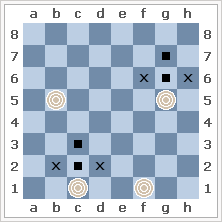
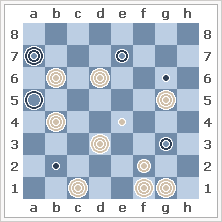
- Takes and turnovers with his Pawn's piece, just like a Pawn.
- There is no “en Passant” movement.
- Each Castle, including those formed along match, may choose to move one or two vacant squares ahead and can even be combined with a compatible piece (Bishop or Queen) on first or second square ahead.
Knight (external ring + internal ring)
- Moves his external piece (Pawn), just as Knight does on Chess, in other words, it moves in L, two squares horizontally or vertically and then one square vertically or horizontally and vice-versa. It is the only movement that allows the piece to jump over pieces.
- Combines his Pawn's piece with a friendly or enemy Bishop to turns it on a friendly Knight.
- Combines his Pawn's piece with a friendly or enemy Queen to turns it on a friendly Castle.
- Takes with his Pawn's piece: Knights, Rooks, Pawns and enemy Castles.
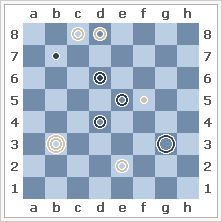
Rules
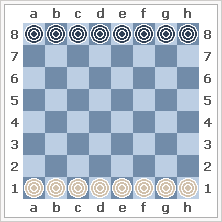
- White moves first, then alternate moves.
- Making a move is required; it is not legal to skip a move, even when having to move is detrimental. If player is unable to move and there is not a checkmate, it’s a draw.
- Touch-move rule. In serious matches, if a player having the move, touches a piece, as if having the intention of moving it, then the player must move it if it can be legally moved. So long as the hand has not left the piece on a new square, any legal move can be made with the piece. If a player touches one of the opponent's pieces then that piece must be captured if there is a legal move that does so. If none of the touched pieces can be moved or captured there is no penalty.
Victory conditions
- The first player to perform checkmate at all enemy Castles wins the match.
- In this game, checkmate concept is much more complex, by the possibility to perform checkmate by checking more than one Castle at same time.
- In addition, may occur a possibility to make another "not in check Castle" while in check, increasing checkmate calculation.
- In this game, checkmate concept is much more complex, by the possibility to perform checkmate by checking more than one Castle at same time.
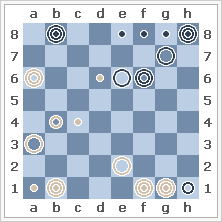
- Last Castles are not taken, but checkmate.
- There is the possibility to checkmate more then one castle at same time.
- Such complex checkmate will require more mental work to calculate. If in doubt, a match can move on, taking pieces until checkmate becomes clearer.
- Players may move on after checkmate if it is contested. In this case, the match needs to move on until last Castle be taken.
- Checkmate calculation requires more computer processing, which can be solved by replacing checkmate calculation by simple check of who first ran out of a Castle.
- Last Castle Resign. Players may resign, moving its last Castle not in checkmate.
- 50 moves Draw: After 50 moves without any taken or turnover (over enemy pieces).
- Remembering: "turnover" is the move where you turn an opponent piece to you.
- Draw: By agreement between the two parties.
- Due to material insufficiency: When both players agree that it is impossible to end the game because of lack of pieces to perform a take or turnover move.
- The repetitive triple rule: If a player performs 3 repetitive moves, either player can claim a draw.
- We know this is a complex rule, so all we have about this rule on chess is applied on Turnover. Check it up on youtube!
Check and Checkmate
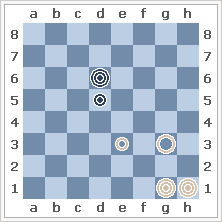
- Castles can be check and checkmate.
- Castles are in check when they are under attack by at least one enemy piece.
- Even if there are several Castles on the board, if each one is in check, it may be considered a check.
- Players do not have to go through the last move to determine the end of the match, because the checkmate is about no possibilities to rest even one Castle on the board. So if it is clear that there is no possibility of saving at least one Castle, the match is done.
- There is the possibility to checkmate more then one castle at same time.
- Take with your last Castle the last opponent's Castle is an illegal move, because the result is no Castle on board.
- Suppose the Kings are inside the last Castle, and on Chess, Kings never die, the match reaches the end on checkmate, so this is an illegal move.
- A Castle in check can move if there is one or more other Castles not in check.
- A Castle in check can move to combine with a Queen to make a new Castle, just if this new Castle ends turn not in check.
Tricks:
- Pay attention before move:
- Are my Castles safe?
- Are my Bishops safe?
- There are any opponent move that can create two or move consecutive attacks against your Castles and or Bishops?
- Avoid making moves that result in the loss of Bishops, so you end up with fewer Bishops than your opponent in next turns.
- Avoid put two or more Bishops at same front line, because opponent Pawn may create double attack hard to swallow.
- Avoid take pieces if in next opponent move he will turnover your piece, so you will be the one who lose the piece.
- If you have an important piece being threatened and you have no way to make a light curtain (put a piece on the way), try to find some movement that threatened an important opponent piece to make him protect his piece so you can solve previous situation.
- Try use your resources (Castles) as well as your opponent is doing.
- If you disassemble many Castles, your opponent will focus his efforts on remaining Castles to force a victory.
- Try to keep pressure from the start by creating attack moves to keep opponent mind occupied.
- Pawns may be used as light curtain if it has a friendly Bishop or Queen or even an opponent piece on diagonal forward to perform a turnover, releasing its column to Queen on first line to atack opponent Castles on last row.
- Knights may be used on third row to perform a backward movement under a friendly Queen on first row, with ideas of recreating a Castle protected from its own Pawn previously moved forward.
- Avoid Take Castles with Bishop if the result is the opponent turnover your Bishop with Rook. The result is that you lose your Bishop and he just lose a Pawn and a Rook. Bishops are the most versatile and important pieces at this game.
Turnover match example:
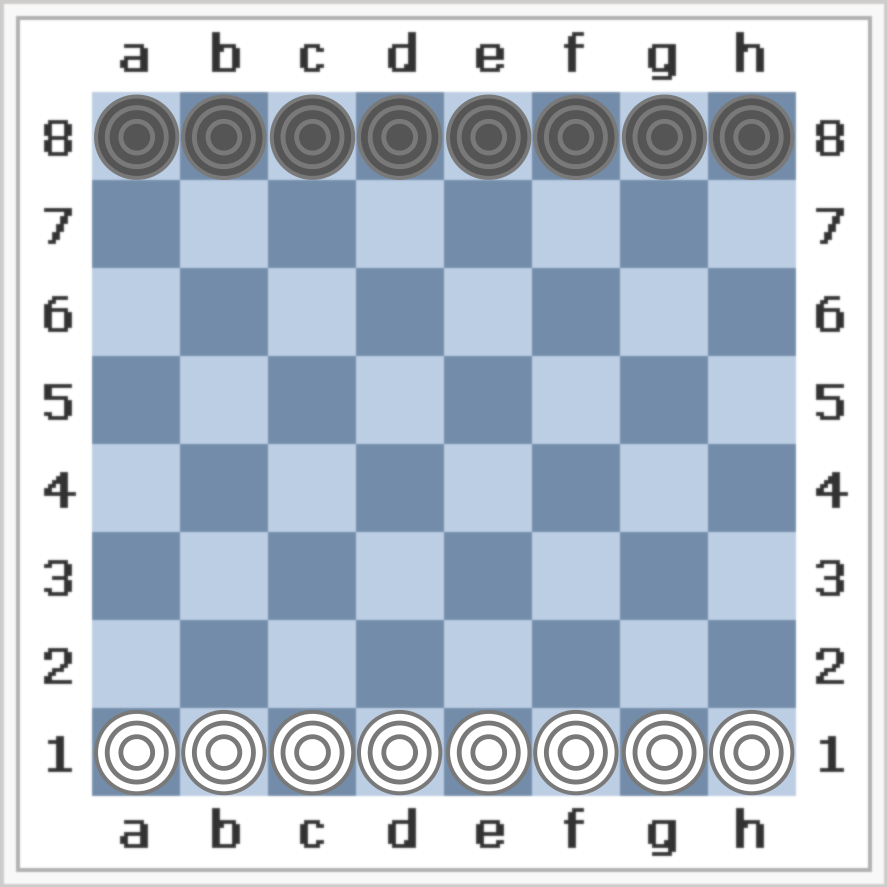
Simulating a real Castle with pieces.
It is easy to grab and move pieces and gives better view to the game.
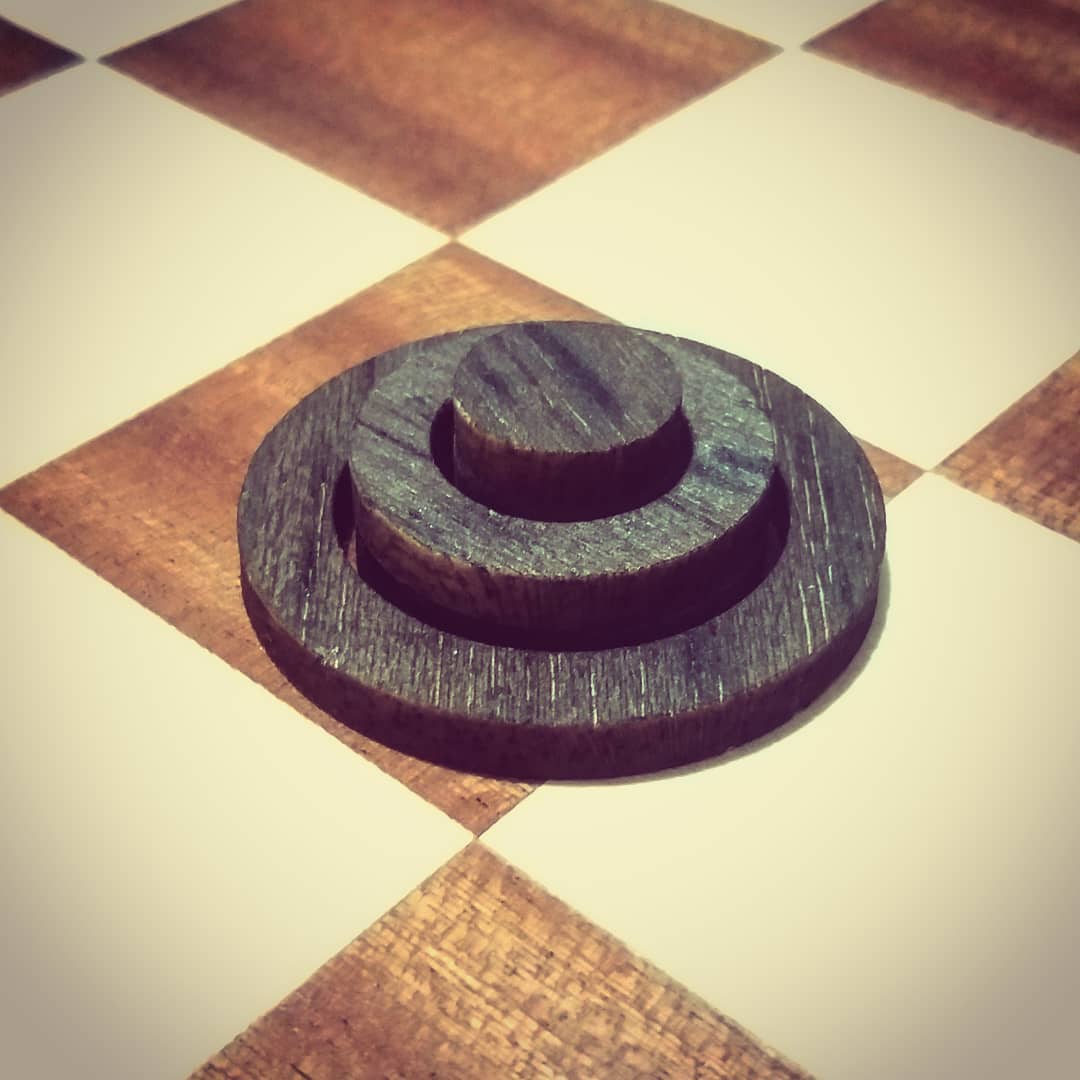
You can play Turnover on MindSports.nl:
Sign up to play Turnover player vs player:
Instructions:
- Sign up
- Select the games you want to play and select Turnover too.
- Click Play / Watch
- Put your email and click Challenge to find other Turnover players.
A few details:
- You can always undo your move, after submitting one. When players cooperate multiple undo is possible.
- A player is supposed to resign (or negotiate a draw) to finish a game. When your opponent detects a win/loss/draw, it is "not" communicated to the MindSports system:( Player still needs to "resign" to acknowledge the outcome).
- So if your last move results in a loss-message from your opponent, don’t submit it, but resign instead, please. On a win-message, move still must be submitted to allow the opponent to resign.
Or play Turnover player vs computer at: http://mindsports.nl/index.php/dagaz/822-turnover-ai
Notes
Turnover Chess Variant Notation
Is a system developed to record all moves. As Turnover pieces have "turnover" special ability, some changes on algebraic notation are needed.
Naming pieces
- C Castle (but notations is not needed, like Pawn)
- Q Queen
- B Bishop
- R Rook
- K or N Knight
- Pawn has no letter
- King has no letter (it is assumed that he is inside the last castle which will be revealed in the checkmate)
Move
Moves are indicated by point (.). By the way, for lonely pieces, indicate moves with point is not needed. Ex.: Be5, e5, Ra5
Examples:
- Re5
- Re15 (disambiguation)
- Be5
- Bc3e5 (disambiguation)
Moves resulting in combining friendly pieces:
- Qe5
- Re1Q5 (disambiguation)
- Ne5
- Nd3Ne5 (disambiguation. This notation reflects a Knight in d3 moving to combine its pawn piece with a friendly Bishop in e5)
- Re1C5
Turnover
This name defines a special ability's to take opponent's pieces without removing them from board. This move is called turnover.
When a player performs a turnover, this move is indicated with two points (:).
Combining pieces of same color is not considered a turnover, so these kinds of movements are not indicated by two points, but just by its final result. This difference is needed because a turnover is considered a valid move to reset 50 moves’ rule.
Examples:
- When a White Rook in e1 combines with a Black Bishop in e5: Qe5 (when disambiguation is not needed) Re1Q5 (when disambiguation is needed)
- When a White Rook in e1 combines with a White Bishop in e5: Qe5 (when disambiguation is not needed) Re1Q5 (when disambiguation is needed)
- When a White Pawn in e1 turnover forward with Black Bishop in e2: Ke2 (impossible to happen a disambiguation in this case)
- When a White Pawn in e1 combines forward with White Bishop in e2: Ke2 (disambiguation in this case e1Ke2)
Takes
Takes are indicated by letter x.
Example:
- RxRe5
- Re1xR5 (disambiguation)
- xRe5 (pawn has no letter)
- d4xRe5 (disambiguation)
- Rxe5 (Rook takes pawn in e5)
- Re1x5 (Rook takes pawn in e5) (disambiguation)
Promotion
- When a White Pawn reaches last row, in turnover with Black Queen: :Qe8 (note that Pawn is removed from board and black pieces are flipped to match color white)
- When a White Pawn reaches last row, in turnover with White Queen: Qe8 (note that Pawn is removed from board and white pieces do nothing, so combine Pawn with friendly Queen can be considered as useless move unless player want to release pieces left behind or the square itself empty)
- When a White Pawn reaches empty last row: Qe8 (note that Pawn is removed from board)
- When a White Pawn reaches last row, in take with Black Pieces: xRd8Q (note that Pawn is removed from board and black pieces are flipped to match color white) e7xRd8Q (disambiguation)
- When a White Pawn from a White Knight reaches last row, in turnover with Black Queen: Qe8 (note that Pawn is removed from board and black pieces are flipped to match color white) Kd6Qe8 (disambiguation)
- When a White Pawn from a White Knight reaches empty last row: Qe8 (note that Pawn is removed from board and black pieces are flipped to match color white) Kd6Qe8 (disambiguation)
- When a White Rook in e1 reaches last row in turnover with Black Knight: Qe8 (note that Pawn is removed from board and pieces are flipped to match color white) Re1Q8 (disambiguation)
- When a White Rook in e1 reaches last row in turnover with White Knight: Qe8 (note that Pawn is removed from board)
- When White Castle in e6 reaches last row in turnover with Black Queen: Qe8 Ce6Q8 (note that repeat column letter is not needed) (disambiguation is needed if R in a8 as example)
Check, Mate and Draw
- Check is indicated by +.
- Checkmate is indicated by ++.
- Draw offer accepted is indicated by =.
- Draw by other reason is indicated by ½.
End game
- The notation 1-0 at the completion of moves indicates that White won, 0-1 indicates that Black won, and = or ½ indicates a draw.
 This 'user submitted' page is a collaboration between the posting user and the Chess Variant Pages. Registered contributors to the Chess Variant Pages have the ability to post their own works, subject to review and editing by the Chess Variant Pages Editorial Staff.
This 'user submitted' page is a collaboration between the posting user and the Chess Variant Pages. Registered contributors to the Chess Variant Pages have the ability to post their own works, subject to review and editing by the Chess Variant Pages Editorial Staff.
By Lúcio José Patrocínio Filho.
Last revised by Lúcio José Patrocínio Filho.
Web page created: 2019-06-24. Web page last updated: 2019-06-24
